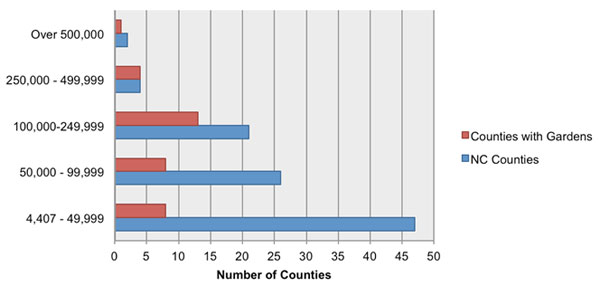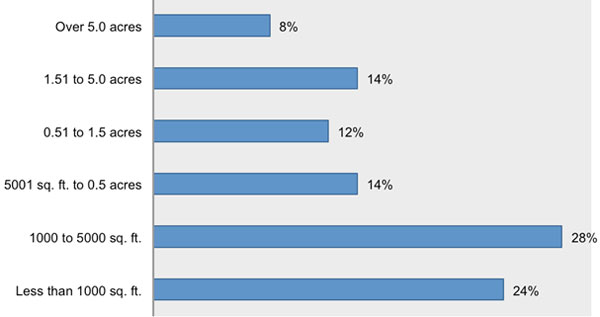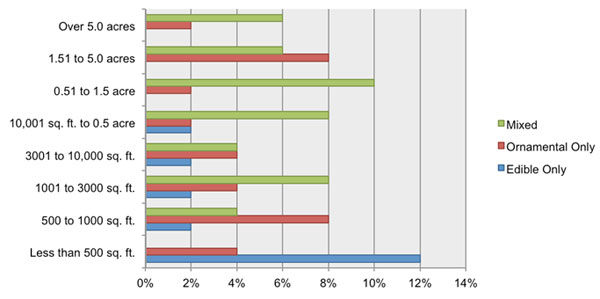 |
April 2013
|
April 2013 // Volume 51 // Number 2 // Research In Brief // v51-2rb8
Characteristics of Extension Demonstration Gardens
Abstract
Extension agents across the country are using demonstration gardens to teach a variety of horticultural principles and practices. Descriptive data about the physical and management characteristics of gardens maintained for Extension programming in North Carolina were gathered from 35 horticulture agents. Gardens were found to most likely be developed at the county Extension center, be less than 0.5 acres, display a combination of edible and ornamental plants, and occur in counties with populations over 100,000 where Master Gardener Programs include at least 25 active volunteers. Master Gardener Volunteers emerged as the major source of funding and support for these gardens.
Introduction
Google the terms "Extension" and "demonstration garden," and one will quickly realize how widespread the use of this educational tool is in Extension programming. Extension agents across the country are developing gardens to teach homeowners, Master Gardeners, youth, green industry professionals, and others about a range of issues, including water conservation, pollinator preservation, food production, sustainable maintenance practices, and locally adapted plants.
The reasons to incorporate gardens into Extension programming are compelling. As an educational setting, gardens make possible the type of sensory, exploratory experiences recommended for Extension's educational delivery systems (Richardson, 1994). When combined with a traditional classroom experience, visits to demonstration sites such as gardens have increased learning and affected attitude change more so than a classroom experience or site visit alone (Harmon & Jones, 1997).
In addition to enhancing classroom instruction, gardens can also support self-directed learning (Butler & Serrell, 2000; Falk & Dierking, 2000; Hamilton & DeMarrais, 2001). These instructor-free learning experiences can result in both short- and long-term outcomes that include knowledge gain, increased curiosity, improved skills, problem solving, behavior change, increased confidence, and attitude change (Butler & Serrell, 2000).
The value of demonstration gardens to Extension programs extends beyond their educational efficacy. Master Gardeners have been shown to anticipate being involved in the development and maintenance of demonstration gardens as part of their volunteer service (Mayfield & Theodori, 2006) and to value the hands-on experience and community involvement this type of volunteering provides (Schrock, Meyer, Ascher, & Snyder, 2000).
Additionally, the development of gardens has been suggested as a catalyst for initiating lasting, mutually beneficial community collaborations and partnerships (Renquist, 2005). The establishment of collaborations and partnerships and use of volunteers to extend educational reach have both been identified as sources of excellence for Extension (Archer, Warner, Miller, Clark, James, Cummings, & Adamu, 2007).
While research supports the use of demonstration gardens in Extension programming, an extensive search of the literature could find no studies of the physical characteristics of these gardens or how agents are managing them. What size are they? Where are they located? What types of plants are displayed? How are agents supporting their development and maintenance? Answers to these questions would provide guidance to agents embarking upon garden development as well as to agents seeking to expand or improve existing gardens.
Purpose
The purpose of the study reported here was to investigate the physical characteristics of Extension demonstration gardens and the management practices of horticulture agents using them for Extension programming in North Carolina.
Methodology
During the summer of 2010, horticulture Extension agents in North Carolina were asked by email to self identify if they currently maintained a demonstration garden as part of their programming. For the study, a demonstration garden was defined as a landscape or garden planting designed and maintained under the supervision of a horticulture Extension agent for the purpose of teaching horticultural principles and practices as part of an Extension education program and could refer to a single bed planted with one specific theme or a series of gardens designed to teach about many different ideas or practices. Demonstration sites and school gardens whose development and maintenance were not under the supervision of Extension professionals, as well as community gardens that did not include some demonstration aspect, were not included in the study.
Of the 90 horticulture agents employed by NC Extension at the time of the survey, 35 responded that they currently maintained one or more demonstration garden as part of their Extension program. All 35 agents agreed to participate in a structured phone survey designed to collect descriptive data about the physical and management characteristics of these gardens. The survey instrument, composed of 18 open- and close-ended questions, was validated by a panel that included a county horticulture agent, the North Carolina Extension Urban Horticulture Specialist, and two members of North Carolina State University's Department of Agricultural and Extension Education faculty. Phone interviews were conducted over a 2-month period in the late summer and early fall of 2010.
Findings
Thirty-five agents based in 34 of North Carolina Cooperative Extension's 101 county centers reported using a total of 50 Extension-maintained demonstration gardens for educational programming. Eight agents were managing gardens in two or more locations, with three maintaining gardens on four separate properties. Gardens were distributed throughout the state (Figure 1).
Figure 1.
NC Counties Maintaining Extension Demonstration Gardens

Demonstration gardens were more likely to be part of Extension programs in counties with populations over 100,000, though programs in counties of all population ranges had developed gardens (Figure 2).
Figure 2.
Distribution of Demonstration Gardens by Population of NC Counties

Garden Characteristics
Location
Fifty percent of gardens were located at the county Extension center. An additional 26% were located on some other county-owned property such as a county park or library. Ten percent of gardens were located on the property of a nonprofit entity such as an environmental education center or museum, while 8% were developed on state-owned properties. Two gardens (4%) were located on private property, and only one garden had been developed on a commercial property.
Size
Size was recorded based on the amount of area currently developed, not the total amount of area available. The majority of gardens were small, with 66% less than 0.5 acres in size. The most frequent size range reported was between 1,000 and 5,000 square feet (28%). Only four gardens (8%) exceeded 5.0 acres in size (Figure 3).
Figure 3.
Distribution of Extension Demonstration Gardens by Size

Age
Garden age was determined by recording the year of establishment. The majority of gardens, 66%, were less than 10 years old, having been established since 2001, with 36% established between 2006 and 2010. Twenty-six percent of gardens were established between 1991 and 2000, while only 8% were initiated before 1991. The oldest garden identified, the New Hanover County Extension Arboretum, was established in 1985.
Plant Composition
The plant composition of each garden was recorded and categorized as one of the following:
- Edible only—Gardens containing only vegetables, culinary herbs, and/or fruit bearing plants.
- Ornamental only—Gardens containing only plants grown for their ornamental value, including annuals, perennials, bulbs, ornamental grasses, trees, shrubs, and turfgrasses.
- Mixed—Gardens containing both edible and ornamental plants.
Nearly half of gardens (46%) displayed a combination of edible and ornamental plants. Thirty-four percent were dedicated to ornamental plants only and 20% to edible plants only.
The distribution of gardens by plant composition and size was charted (Figure 4). The smallest gardens were found to most likely be dedicated to edible plants, with only one edible-plant garden exceeding 5,000 square feet. Ornamental-only and mixed-planting gardens were found to occupy a wide range of sizes. Like the edible-only gardens, the majority of ornamental gardens fell within the range of less than 5,000 sq. ft., while mixed gardens were found to be more evenly distributed over all size ranges.
Figure 4.
Distribution of Gardens by Size and Plant Composition

The distribution of gardens by plant composition and year of initial construction was also charted (Figure 5). The most recently developed gardens were most likely to be composed of edible only plants, with only one edible plant garden exceeding 10 years in age. Eight of the 10 edible only gardens had been established in the last five years, with three of them breaking ground in 2010. Both ornamental only and mixed gardens had been established over a wide range of years, though the two oldest gardens contained mixed plantings.
Figure 5.
Distribution of Gardens by Year Initiated and Plant Composition

Garden Management
Agents were asked how their demonstration garden was supported, both in terms of funding and labor. Garden development and maintenance were accomplished primarily through volunteer efforts, with agents in only three counties reporting any paid staff dedicated to garden maintenance.
Support
All agents were asked if they received any source of support for their garden, with "support" defined as funding, donations of materials or services, or volunteer service. Thirty-four of the 35 agents reported at least one source of support, with a total of 15 sources reported (Table 1). The source of support identified most frequently was Master Gardener Volunteers (31 times), followed by garden centers and nurseries (24 times), and county government (22 times).
Agents were asked to categorize the nature of the support provided by each source as occurring on a "one time," "occasional," or "ongoing" basis. Master Gardeners were identified more frequently than any other category as an "ongoing" supporter of Extension demonstration gardens (26 times), followed by county government (18 times). Garden centers and nurseries were the most frequently identified providers of "occasional" support (18 times), while non-horticultural businesses were the most frequently identified "one" time supporters (six times).
| Support Source | One Time | Occasional | Ongoing | Total Occurrences |
| Master Gardener Volunteers | 0 | 5 | 26 | 31 |
| Garden Centers and Nurseries | 1 | 18 | 5 | 24 |
| County Government | 2 | 2 | 18 | 22 |
| Garden Clubs | 1 | 8 | 3 | 12 |
| Landscape Service Companies | 4 | 4 | 4 | 12 |
| 4-H Volunteers | 1 | 6 | 2 | 9 |
| Businesses | 6 | 3 | 0 | 9 |
| Host Sites | 0 | 0 | 8 | 8 |
| Youth Organizations | 1 | 6 | 1 | 8 |
| City or Town | 2 | 0 | 4 | 6 |
| Civic Club | 2 | 3 | 1 | 6 |
| Community College | 2 | 3 | 1 | 6 |
| Private Citizens | 1 | 1 | 3 | 5 |
| Non Profit Organization | 1 | 2 | 2 | 5 |
| High School | 0 | 4 | 1 | 5 |
Funding
In addition to sources of support, sources of funding for the gardens' establishment and maintenance were identified (Table 2). The most common funding source was Master Gardener Programs, cited by 22 agents (63%). Many agents stated that their Master Gardener Program made regular contributions to the garden, raising funds through plant sales, cookbook sales, or other activities. The second most common source of funding was grants, cited by 12 agents (34%). These funds were usually of a onetime nature rather than ongoing and were most likely to come from a local business or organization. County government was cited by 31% of agents as providing funding for the gardens, most commonly as a line item in the county Extension budget.
| Funding Source | # Reporting | % Reporting |
| Master Gardener Program | 22 | 63 |
| Grants | 12 | 34 |
| County Government | 11 | 31 |
| Agent Generated Funds | 7 | 20 |
| Donations | 6 | 17 |
| Garden Fundraisers | 3 | 9 |
| Paid Memberships | 3 | 9 |
| Host Site | 3 | 9 |
| Programming Partner | 1 | 3 |
Volunteers
Agents were asked if volunteers were involved in any aspect of the gardens' development, maintenance, or use. Thirty-four agents (97%) responded yes. Only one agent responded no. Agents were then asked to identify the affiliation of volunteers helping with their garden. The vast majority (31 agents, 91%) identified Master Gardeners as their main volunteer force.
The 31 agents who employed Master Gardener Volunteers for garden management were asked how many volunteers were active in their total Master Gardener program. The majority maintained programs of 25 to 74 active volunteers, with 29% managing programs of 25-49 active volunteers, and 29% managing programs of 50 - 74 active volunteers. Only 10% supervised programs of fewer than 25 active Master Gardeners, while 32% managed programs ranging from 75 to 225 volunteers.
Agents were asked to identify the roles Master Gardener Volunteers play in their gardens' development, maintenance, and use (Table 3). The three most frequently identified roles of Master Gardeners were: 1) "Maintain Plantings," reported by 97% of agents; 2) "Install Plantings," 90%; and 3) "Fundraising," 81%.
| Volunteer Role | # Reporting | %Reporting |
| Maintain Plantings | 30 | 97 |
| Install Plantings | 28 | 90 |
| Fundraising | 25 | 81 |
| Design Plantings | 24 | 77 |
| Lead Tours | 20 | 65 |
| Lead Garden Demonstrations | 19 | 61 |
| Garden Publicity and Marketing | 16 | 52 |
| Develop Materials for Use in Garden | 10 | 32 |
In addition to the descriptive data collected about volunteer involvement and roles, agents were asked what they most needed to achieve their goals for their gardens. Twenty-one percent of agents replied "More Time," while 42% said "Money." By far the most important resource agents identified as necessary to achieve their goals was "Committed Volunteers" (67%). As part of his response to this question one agent stated, "Money is nice but people are more important. If we have the people we can get the money."
Conclusions and Recommendations
The use of demonstration gardens in Extension horticulture programming appears to be a growing trend in North Carolina. Over the last 5 years the number of gardens demonstrating the production of edible plants has particularly increased, a trend that may be attributed to the promotion of local foods initiatives in North Carolina.
The importance Master Gardener Volunteers play in the development and management of Extension demonstration gardens cannot be overstated. Master Gardeners emerged as the major source of ongoing support for these gardens in North Carolina, as well as the most common providers of volunteer labor and funding.
While the size, plant composition, location, and level of volunteer support of gardens will be reflective of each program's unique needs and resources, findings from the study reported here support the following recommendations:
- Gardens are more likely to be sustained in counties with populations over 100,000, where the Extension program includes a Master Gardener Program of 25 or more active volunteers.
- Small gardens, of less than 0.5 acre, located at the county Extension office or another county property, are most realistic to manage.
- A variety of partners, including county government, green industry businesses, volunteers, and garden clubs, should be engaged in the support of Extension demonstration gardens.
- Gardens should be used to employ the talents and interests of volunteers, particularly Master Gardeners.
- The interest and support of Master Gardeners should be maintained by actively involving them in the garden's planning, installation, maintenance, and educational use.
- The number and commitment level of volunteers should be a key factor in determining the size of a new garden or garden expansion project.
Acknowledgments
The findings reported here are from a larger study conducted for a master's thesis. In addition to identifying the physical and management characteristics of Extension demonstration gardens in North Carolina, the study also investigated how agents' used gardens for educational programming and what they perceived to be the benefits and challenges of doing so. The complete thesis is available online from NCSU Libraries at http://www.lib.ncsu.edu/resolver/1840.16/6483.
References
Archer, T. M., Warner, P. D., Miller, W., Clark, C. D., James, S., Cummings, S.R., et al. (2007). Excellence in Extension: Two sources of definition and measurement. Journal of Extension [On-line], 45(1) Article 1TOT1. Available at: http://www.joe.org/joe/2007february/tt1.php
Butler, B. M., & Serrell, B. (2000). Informal learning in public gardens: The process and the product. In American Association of Botanical Gardens and Arboreta, Reaching out to the garden visitor, Chapter 2.
Falk, J., & Dierking, L. D. (2000). Learning from museums. Walnut Creek, CA: Alta Mira Press.
Hamilton, S. L., & DeMarrais, K. (2001). Visits to public gardens: Their meaning for avid gardeners. HortTechnology. 11(2), 209-215.
Harmon, A. H., & Jones, S. B. (1997). Forestry demonstration: What good is a walk in the woods? Journal of Extension [On-line], 35(1) Article 1RIB3. Available at: http://www.joe.org/joe/1997february/rb3.php
Mayfield, C. A., & Theodori, G.L. (2006). Past and anticipated community involvement of master gardener trainees. Journal of Extension [On-line], 44(3) Article 3RIB8. Available at: http://www.joe.org/joe/2006june/rb8.php
Renquist, S. B. (2005). Finding hidden partnerships to create a teaching garden. Journal of Extension [On-line], 43(5) Article 5IAW4. Available at: http://www.joe.org/joe/2005october/iw4.php
Richardson, J. (1994). Learning best through experience. Journal of Extension [On-line], 32(2) Article 2FEA6. Available at: http://www.joe.org/joe/1994august/a6.php
Schrock, D. S., Meyer, M. Ascher, P., & Snyder, M. (2000). Benefits and values of the Master Gardener Program. Journal of Extension [On-line], 38(1) Article 1RIB2. Available at: http://www.joe.org/joe/2000february/rb2.php




